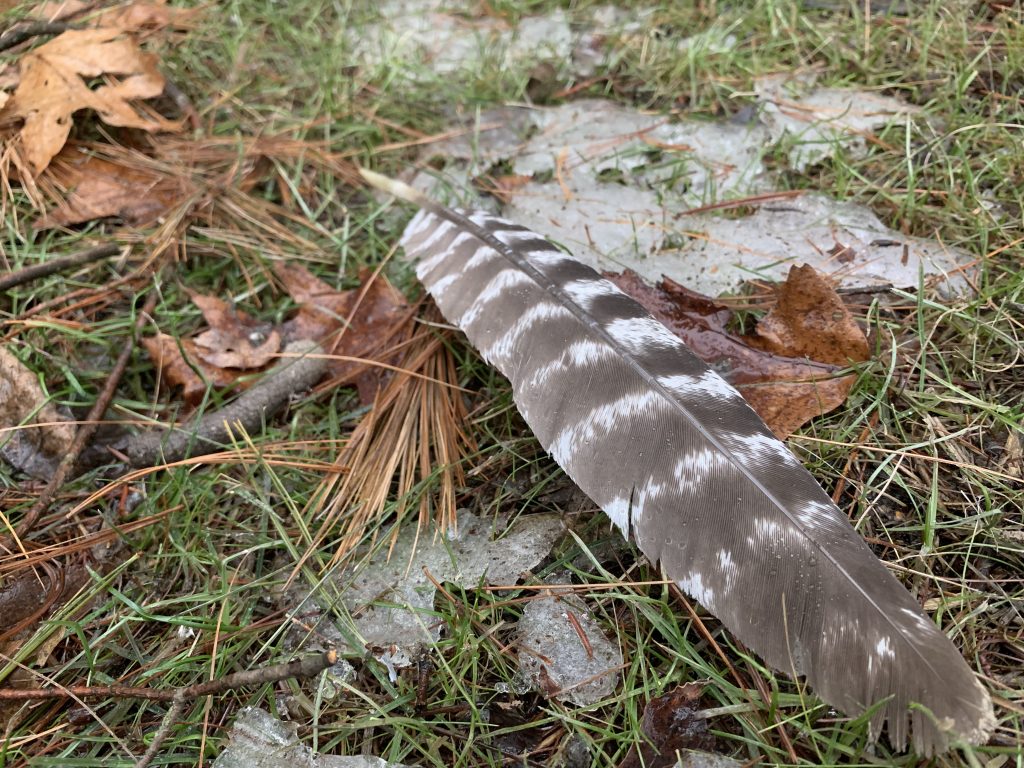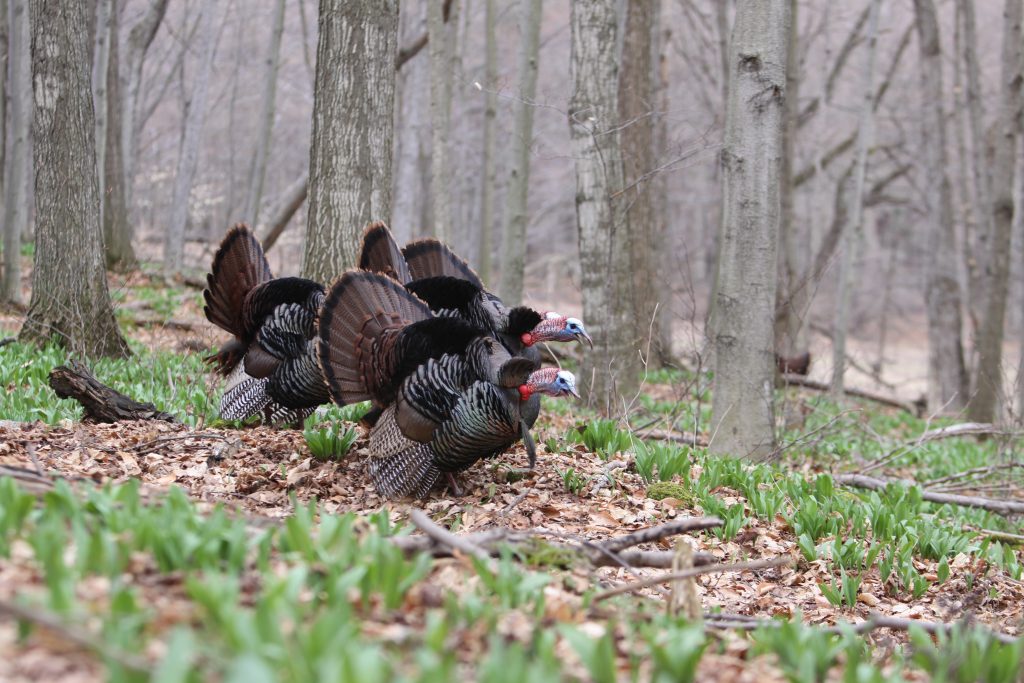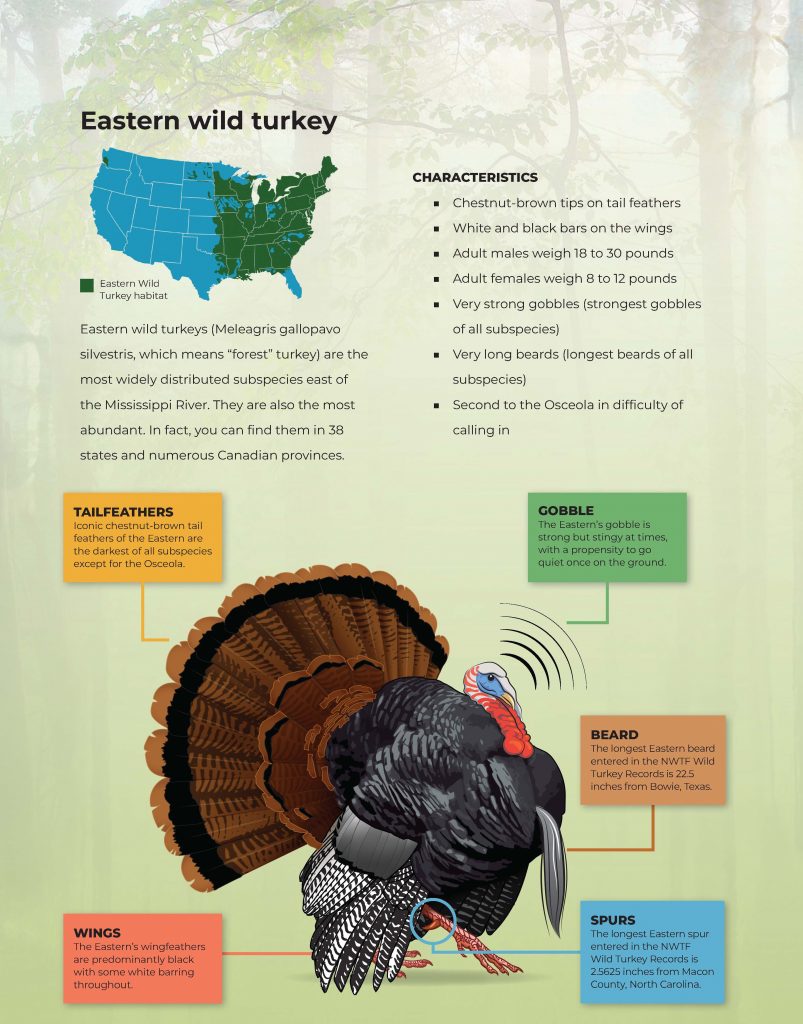Behind The Bird: History And Conservation Of The Eastern Wild Turkey
A once-declining lot, the Eastern wild turkey is an amazing conservation win.
Gobblers sounded off in all directions as my brother, Joe, and I positioned a ground blind and plugged decoys into the Wisconsin soil. As dawn cracked, most of the gobbling faded, although one tom’s gobbles were increasing in volume. “He’s in the field,” Joe soon whispered.
I peeked out the blind. Sure enough, the gobbler was fully displayed 120 yards away. Despite our decoys and calling attempts, he wouldn’t budge. Eventually, he faded back into the timber along with my hopes and dreams.
Suddenly, three jakes approached our decoys. Just a young teenager looking for my first male bird, Joe challenged me, “If you’re going to shoot a jake, shoot for the head.” My first arrow narrowly missed, and the bewildered birds slowly walked away, still musing at our decoys. I nocked another arrow and anchored the closest bird with a perfect headshot.
That two-decades-old story began my obsession with hunting the Eastern wild turkeys, and I’ve since taken dozens of Eastern gobblers — not to mention many fall birds — by both bow and shotgun. I’ve spent more than 20 years hunting, scouting, observing and photographing them. Having nabbed the Grand Slam with my bow, no other subspecies provides the thrill and challenge of Easterns.
While I know hunting Easterns like the back of my hand, I recently discussed history and conservation with Doug Little, NWTF’s director of conservation operations for the East, who provided some insights into the history of this grand wild turkey subspecies.

The Eastern’s Historical and Current Ranges If you’re young, new to turkey hunting or simply haven’t researched Easterns, then perhaps you’re unaware they once were considered a lost cause.
“Fifty years ago,” Little said, “Eastern wild turkey populations already had begun their rebound, thanks to landscape-scale habitat changes as farmlands were abandoned and forests began to reemerge. Prior to this, Easterns were declining significantly; there was minimal hope that they’d rebound. Wild turkeys were extirpated from as many as 15 states.”
Thanks to the work of the NWTF, state wildlife agencies and other conservation partners who cared for and invested in the once-declining bird, Eastern turkeys thrive today in 38 states and four Canadian provinces.

“They’ve responded to changing habitat conditions when comparing today’s landscapes to those of 50 years ago,” Little explained. “Wildlife managers have aided their recovery using science-based decisions: trap-and-transfer, active habitat management, harvest regulations, law enforcement and educational materials. While trap-and-transfer is largely completed — save for a few cases like the East Texas Super Stocking Program — vigilant monitoring and research continues to help biologists better understand wild turkey limiting factors.
“It’s difficult to say if the Eastern’s range will continue expanding,” he added. “However, I anticipate numbers will always fluctuate based on habitat and environmental factors that impact annual reproduction and poult survival within their range.”

How Conservation Saved the Eastern
Knowing that Easterns were once a declining lot lacking a hopeful future, conservation is to thank for their current abundance.
“Increased wild turkey numbers can be attributed to many factors,” Little said. “The early wild turkey restoration pioneers laid the groundwork for other wildlife managers to understand the how, when and where to utilize trap-and-transfer of wild turkeys to suitable habitats where turkeys didn’t previously exist. NWTF played a key role by funding critical research used by wild turkey managers to better understand wild turkey biology, habitat use and how to capture and relocate wild turkeys.
“There were numerous cases during wild turkey restoration efforts where state agencies provided wild turkeys to other states to release them into quality habitats lacking birds,” Little continued. “Federal agencies and private landowners also allowed access to both capture wild turkeys and release them on their properties to assist with restoration. Agencies and landowners cooperated well.”
Little said that the work didn’t end with restoration.
“Appropriate fall and spring hunting season structures, law enforcement and data collection (harvest data, annual productivity trends, etc.) play large roles,” he said. “Actively managing for their seasonal-habitat needs from southern piney woods, bottomland forests, northern and central hardwoods, plains states and western landscapes has been critical to ensure suitable ground conditions for long-term sustainability. While much of this work plays out in the fields and forests, work in the policy arena is required to advocate for the management authority and provide support to agency partners for their efforts to actively manage the resources.”
Key Conservation Partners
NWTF doesn’t stand alone in the conservation of Eastern wild turkeys.
“There are too many NWTF partners to name individually,” Little shared. “Most notable are the state wildlife agencies. A handful of others include the USDA Forest Service, USDA Natural Resources Conservation Service, U.S. Fish and Wildlife Service, our state forestry agencies and numerous other governmental and nongovernmental organizations. We also collaborate with partners in the policy arena to ensure conservation measures allow for appropriate habitat- and population-management authorities.
“It’s important to acknowledge the National Wild Turkey Federation Technical Committee’s vital role,” he noted. “It consists of natural resource professionals employed by a state, provincial or federal agency who have primary responsibility for wild turkey conservation and management. The Technical Committee offers recommendations for research, biological and technical needs and shares information cooperatively to ensure more informed management-action decisions.”
Threats to the Eastern
Despite all of the conservation and management successes, we cannot ignore the threats to the Eastern.
“The threats are numerous,” Little explained, “including continued erosion of the ability to actively manage public lands at the appropriate pace and scale. Also, there’s a need for educating private landowners to ensure they understand the importance of active management. Development-fueled habitat loss is another threat.”
Little explained some viable ways to combat threats.
“Enhancing habitat on a landscape-level scale across public and private lands can offset impacts of threats such as predators,” he said. “The social license to manage habitats using prescribed burning at appropriate scales is critical, not only for wildlife habitat value but also to improve overall forest health and prevent fuel loads from building, which could result in catastrophic wildfires. Additionally, the loss of hunting access and hunter declines are threats for wildlife species — like the Eastern — that depend on funding provided by excise taxes paid by sportsmen and women.”
What You Can Do
If you love hunting Eastern turkeys and want to be involved so that your children, grandchildren and great-grandchildren can enjoy continued hunting opportunities, consider your options.
“Join NWTF,” Little said. “Even better, join a local chapter committee and find a role that suits your skillset. The more members and the more support we have, the more we can accomplish on the ground and in the policy arena to address wild turkey conservation. Beyond that, introduce and mentor new hunters.”
CONNECT WITH US
National Wild Turkey Federation
770 Augusta Road, Edgefield, SC 29824
(800) 843-6983
National Wild Turkey Federation. All rights reserved.
